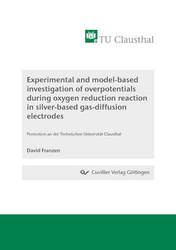| Areas | |
|---|---|
| Serie de libros (96) |
1378
|
| Nachhaltigkeit |
3
|
| Gesundheitswesen |
1
|
| Letra |
2365
|
| Ciencias Naturales |
5406
|
| Matemática | 229 |
| Informática | 319 |
| Física | 980 |
| Química | 1363 |
| Geociencias | 131 |
| Medicina humana | 243 |
| Estomatología | 10 |
| Veterinaria | 108 |
| Farmacia | 147 |
| Biología | 835 |
| Bioquímica, biología molecular, tecnología genética | 121 |
| Biofísica | 25 |
| Nutrición | 45 |
| Agricultura | 1004 |
| Silvicultura | 201 |
| Horticultura | 20 |
| Ecología y conservación de la tierra | 148 |
| Ciencias Ingeniería |
1793
|
| General |
98
|
|
Leitlinien Unfallchirurgie
5. Auflage bestellen |
|
Erweiterte Suche
Experimental and model-based investigation of overpotentials during oxygen reduction reaction in silver-based gas-diffusion electrodes (Tienda española)
David Franzen (Autor)Previo
Lectura de prueba, PDF (180 KB)
Indice, PDF (72 KB)
Chlorine is one of the most important basic chemicals, which is used directly or indirectly in the production of around 60 % of all chemical products. The production is almost exclusively based on energy intensive electrolysis processes, with an average of 2.5 – 3.5 MWh of electrical energy required per ton of chlorine generated. This means that chlorine production alone accounts for around 3 % of the electrical energy used worldwide in industry. By using oxygen depolarized cathodes (ODC), it is possible to reduce the demand for electrical energy on an industrial scale by about 25 %. Instead of hydrogen evolution, oxygen reduction takes place. Due to the low solubility of oxygen, the electrode is designed as a gas-diffusion electrodes (GDE). These are porous silver-based electrodes with hydrophobic regions due to the use of polytetrafluoroethylene (PTFE). During operation, the liquid electrolyte penetrates the pore structure, but the PTFE prevents complete flooding of the electrode. Oxygen is supplied via a gas compartment and enters the internal structure of the electrode. A three-phase interface is formed, consisting of liquid electrolyte, gas and catalytically active solid, at which the electrochemical reaction takes place. Although the technology is already successfully used industrially, many processes, especially the electrolyte distribution, inside the GDE remain unknown.
In this dissertation, the influence of PTFE is first systematically investigated. Subsequently the process is described in a pseudo-2D model supported by operando experiments. Finally, the exact penetration depth of the electrolyte is analyzed using specially designed electrodes.
| ISBN-13 (Impresion) | 9783736975149 |
| ISBN-13 (E-Book) | 9783736965140 |
| Formato | A5 |
| Idioma | Inglés |
| Numero de paginas | 136 |
| Laminacion de la cubierta | mate |
| Edicion | 1. |
| Lugar de publicacion | Göttingen |
| Lugar de la disertacion | Clausthal-Zellerfeld |
| Fecha de publicacion | 26.10.2021 |
| Clasificacion simple | Tesis doctoral |
| Area |
Química industrial e Ingeniería química
Ingeniería mecánica y de proceso Allgemeine Verfahrenstechnik |
| Palabras claves | gas-diffusion electrode, oxygen reduction reaction, graded electrode, modelling, electrolyte distribution, chlor-alkali electrolysis, oxygen depolarized cathode, silver, operando measurements, diffusion, electrochemistry, experimental studies, transport mechanics, Gasdiffusionselektrode, Sauerstoffreduktion, gradierte Elektrode, Modellierung, Modell, Elektrolytverteilung, Chlor-Alkali-Elektrolyse, Sauerstoffverzehrkathode, Silber, Operando-Messungen, Diffusion, Elektrochemie, experimentelle Untersuchungen, Transportmechanismen, energieintensive Elektrolyseverfahren, energy intensive electrolysis processes, electrical energy, Chlorproduktion, Sauerstoffverzehrkathoden, oxygen depolarized cathodes, Wasserstoffentwicklung, hydrogen evolution, Sauerstoffreduktion, oxygen reduction, Gasdiffusionselektrode, gas-diffusion electrode, Synchrotronstrahlung, synchrotron radiation, Elektrodenleistung, electrodes performance, Radiographien, radiographs, Hydroxidionen, hydroxide ions, Elektrochemische Operando-Messung,Operando-Elektrolyt-Verteilung, Operando electrolyte distribution, Polarisationskurve, polarization curve, Elektrolyt-Eindringtiefe, electrolyte intrusion depth, Kapillarflussporometrie, Elektrolyteigenschaften, electrolyte properties, Agglomeratradius, agglomerate radius, Stromdichte, Elektrolytmasse, electrolyte bulk, Gasraum, gas compartment, Umkehrpunkt, reversal point, Intrusionstiefe, intrusion depth, Porennetzwerk, pore network, Elektrolytsättigung, electrolyte saturation, electrowetting, Elektrobenetzung, Brennstoffzellenelektroden, fuel cells electrodes, elektrochemische Reduktion von CO2, electrochemical reduction of CO2 |
| URL para pagina web externa | https://www.icvt.tu-clausthal.de/ |








